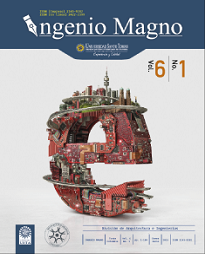Software para el estudio de coberturas vegetales con conceptos de agricultura de precisión
Contenido principal del artículo
Resumen
Descargas
Detalles del artículo
DECLARACIÓN DE ORIGINALIDAD DE ARTÍCULO PRESENTADO
Por medio del presente documento, certifico(amos) que el artículo que se presenta para posible publicación en la revista institucional INGENIO MAGNO del Centro de Investigaciones de Ingeniería Alberto Magno CIIAM de la Universidad Santo Tomás, seccional Tunja, es de mi (nuestra) entera autoría, siendo su contenido producto de mi (nuestra) directa contribución intelectual y aporte al conocimiento.
Todos los datos y referencias a publicaciones hechas están debidamente identificados con su respectiva nota bibliográfica y en las citas que se destacan como tal. De requerir alguna clase de ajuste o corrección, comunicaré(emos) de tal procedimiento con antelación a los responsables de la revista.
Por lo anteriormente expresado, declaro(amos) que el material presentado en su totalidad se encuentra conforme a la legislación aplicable en materia de propiedad intelectual e industrial de ser el caso, y por lo tanto, me(nos) hago (hacemos) absolutamente responsable(s) de cualquier reclamación relacionada a esta.
En caso que el artículo presentado sea publicado, manifiesto(amos) que cedo(emos) plenamente a la Universidad Santo Tomás, seccional Tunja, los derechos de reproducción del mismo.
Citas
Yitong, W. y Butcher, S. (2014). Design of multiparameter wireless sensor network monitoring system in precision agriculture. Fourth International Conference on Instrumentation and Measurement, Computer, Communication and Control (pp. 721-725). Harbin, China.
Sass, J. (2007). Low cost, high accuracy, GNSS Survey and Mapping. 6th FIG Regional Conference: Strategic Integration of Surveying Services. San Jose, Costa Rica.
Dabove, P. y Manzino, A. (2014). GPS mass-market receivers for precise farming. Position, Location and Navigation Symposium – PLANS, IEEE/ION, Monterrey.
Hatfield, J. L., Gitelson, A. A., Schepers, J. S. y Walthall, C. L. (2008). Application of spectral remote sensing for agronomic decisions, Agron. J., 100, S117-S131.
Abril, P. y Butcher, S. (2001). Overgrazing and soil carbon dynamics in the western Chaco of Argentina. Appl. Soil Ecology, 16, 243-249.
Shanahan, J. F., Kitchen, N. R., Raun, W. R. y Schepers, J. S. (2008). Responsive in-season nitrogen management for cereals, Comput. Electron. Agric., 61, 51-62.
Shuanghui, L., Ren, D., Huang, Z., Xiao, T. y Zhang, L. (2014). Comparison of Feature point extraction methods based on UAV remote sensing image. 11th World Congress on Intelligent Control and automation. Shenyang, China.
Inoue, Y., Morinaga, S. y Tomita, A. (2000). A blimp-based remote sensing system for low-altitude monitoring of plant variables: A preliminary experiment for agricultural and ecological applications, Int. J. Remote Sens., 21, 379-385.
Changchun, L., Li, S., Hai, W. y Tianjiel, L. (2010). The Research on Unmanned Aerial Vehicle Remote Sensing and Its Applications. Advanced Computer Control (ICACC). Shenyang, Liaoning, China.
Hoffer, A. (1978). Biological and physical considerations in applying computer-aided analysis techniques to remote sensor data (1. ed.). Nueva York: McGraw-Hill.
Zhan, Y., Huang J. y Tao, R. (2008). Characterizing and estimating fungal disease severity of rice brown spot with hyperspectral reflectance Data. Journal LIU Rice Science, 15(3), 232-242.
Meer, F. y Jong, S. (2002). Imaging Spectrometry. Remote Sensing and Digital Image Processing. Kluwe Academic Publishers, 4, 111-197.
Geng, L., Ma, M., Yu, W., Xufeng, W. y Jia, S. (2014). Validation of the MODIS NDVI Products in Different Land_Use Types Using In Situ Measurements in the Heihe River Basin. IEEE Geoscience and Remote Sensing Letters, 11(9), 1649-1653.
Carlson, T. N. y Ripley, D. A. (1997). On the relation between NDVI, fractional vegetation cover, and leaf area index, Remote Sens. Environ., 62, 241-252.
Daughtry, C. S., Walthall, C. L., Kim, M. S., Brown, E. y McMurtrey, J. E. (2000). Estimating corn leaf chlorophyll concentration from leaf and canopy reflectance, Remote Sens. Environ., 74, 229-239.

